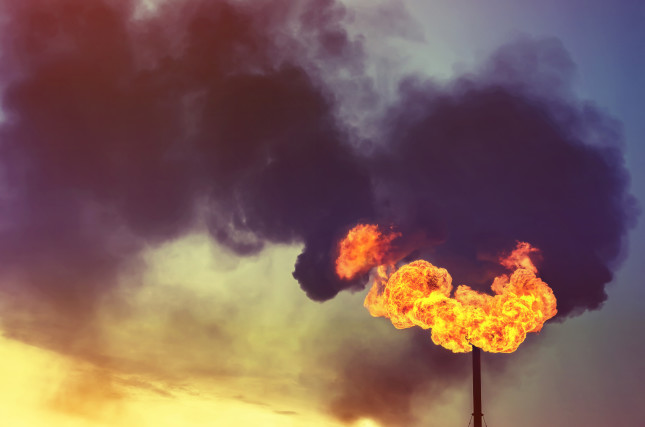-
The Gasses That Will Make or Break Climate Change Mitigation
March 18, 2022 By Katelyn RouschNew worldwide attention on methane has increased the potential for countries to implement methane policy in the energy sector. In November 2021, the countries gathered at COP 26 in Glasgow launched the Global Methane Pledge, an agreement that aims to reduce methane emissions at least 30 percent from 2020 levels by 2030. If the 111 participating countries are successful, this endeavor could curb over 8 gigatons of carbon equivalent emissions and prevent more than 0.2 degrees Celsius in warming by 2050.
Barry Rabe, professor at University of Michigan’s Ford School of Public Policy and author of “Can We Price Carbon?,” discussed the surprising shift in global attention to methane gas at a Ohio University presentation on short-lived climate pollutants. Rabe said that until recently he had been skeptical that international efforts to address methane would lead to GHG emissions reductions—but the recent surge in global attention changed his perspective.
“I’ve rarely had this happen in my career. I wrote a first draft of this paper that’s going to be published soon, in July, and it was actually a pretty cynical paper,” Rabe said. “I am now, with days left on my deadline, dramatically rewriting…because the world has changed. I’ve never seen this kind of change in anything I’ve been writing about. And it has nothing to do with me prompting it…I think methane politics is changing in the United States.”
Studies attribute up to a third of all global warming to a subset of greenhouse gasses that have a lifespan of fewer than twenty years in the atmosphere, said Rabe. “If you release a ton of methane into the atmosphere, it has 87 times the global warming power over an equivalent amount of carbon during its first two decades in the atmosphere.”
The most common short-lived climate contaminates are black carbon, methane, tropospheric ozone, and hydrofluorocarbons (HFCs). In addition to their potent greenhouse effect, several of these gasses are also hazardous to human health, said Rabe. While bipartisan policy and international agreements such as the Kigali Amendment to the Montreal Protocol have begun to address HFCs, the United States has all but ignored the potential of methane capture.
Methane policy is a “low-hanging fruit” strategy governments can institutionalize to have positive climate impacts that are “immediate and front-loaded,” said Rabe. “There is not a single area of climate emissions—certainly compared to carbon—where there are as many technologies and techniques that can be used at low or no cost to capture that gas.”
The primary area where regulations will impact methane emissions is in the energy sector, particularly oil and gas fields where pockets of methane are vented and flared. “Methane, which is the core constituent element in natural gas, has a lot of value,” said Rabe. “So when you see that release occurring [venting and flaring]…that’s wasting a natural resource. You are never going to get it back. It’s costing people and states and businesses money.”
Methane emissions from oil and gas remain high in the United States due to strong state-energy associations that preempt local jurisdiction, downward measurement bias due to a lack of good data, and a laissez-faire approach that allows companies to maximize profit by leaving wells idle or orphaned.
Countries such as Norway and Saudi Arabia have comprehensive methane capture programs the United States could use as a model, said Rabe. Except for programs in New Mexico and Colorado, the United States has lagged in its past agreements related to methane emissions reductions, such as the Three Amigos Summit. However, the Biden Administration announced in November 2021 that the United States would be joining the EU in signing the Global Methane Pledge after proposing the initiative with President Von der Leyen at the Major Economies Forum in September.
Methane, however, is not a byproduct exclusive to oil and gas, said Rabe. It also stems from biological waste aggregated in livestock, landfills, and municipal waste. “If we only focus on the energy sector…if we ignore the agricultural or livestock aspects in the US and internationally, we are only dealing with a small, small portion of this issue,” Rabe said.
Containing emissions of methane and other short-lived, but impactful greenhouse gasses is a critical step to addressing climate change. Methane-capture policy can become a successful climate-change mitigation strategy or a missed opportunity if no further action is taken. “Want to take a dent out of global warming near term or short term? Methane is quite potent,” Rabe said.
Want to read more?
- Merging the Environmental and Security Sectors in Climate Risk Responses
- Best or Worst of Both Worlds? Nuclear Power’s Contested Role in Europe’s Energy Transition
- When Climate Change Meets Geopolitics
Katelyn Rousch is a Voinovich Scholar working in the Davis Research Group at the Ohio University Voinovich School of Leadership and Public Service. She is an Environmental Studies and Economics student in the Honors Tutorial College.
Sources: Center for Climate and Energy Solutions, Colorado Department of Public Health and Environment, Global Methane Pledge, International Energy Agency, Ohio State, New Mexico Energy Department, Time, United Nations, United States Congress, United States Department of Energy, United States Environmental Protection Agency, United States White House, Wilson Center.
Photo Credit: Black smoke from burning of associated gas, courtesy of Leonid Ikan, Shutterstock.com
 A Publication of the Stimson Center.
A Publication of the Stimson Center.




